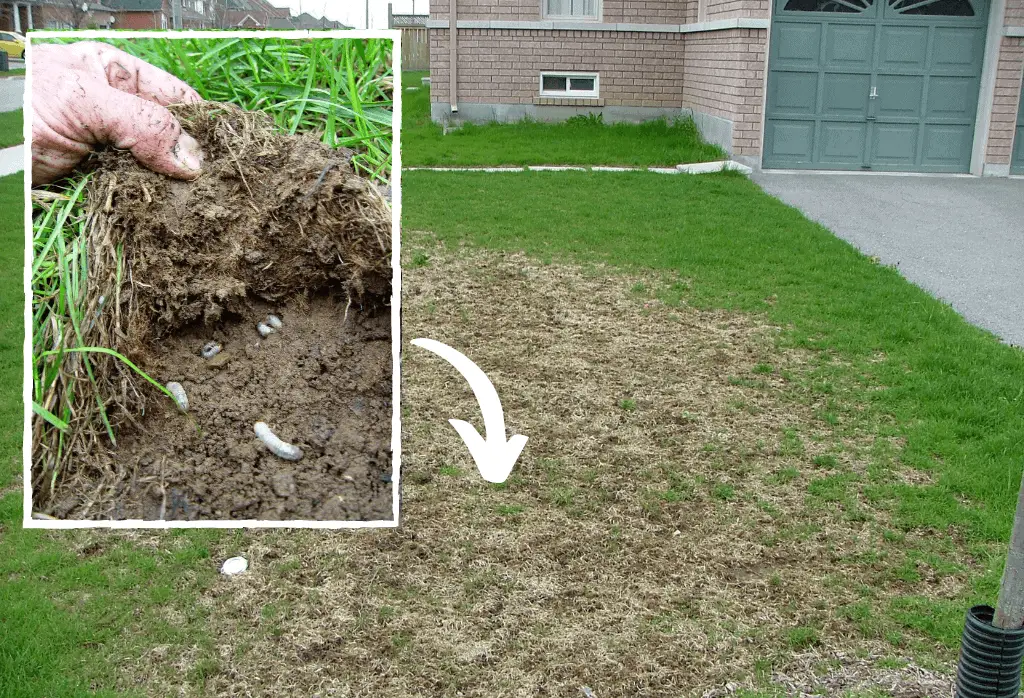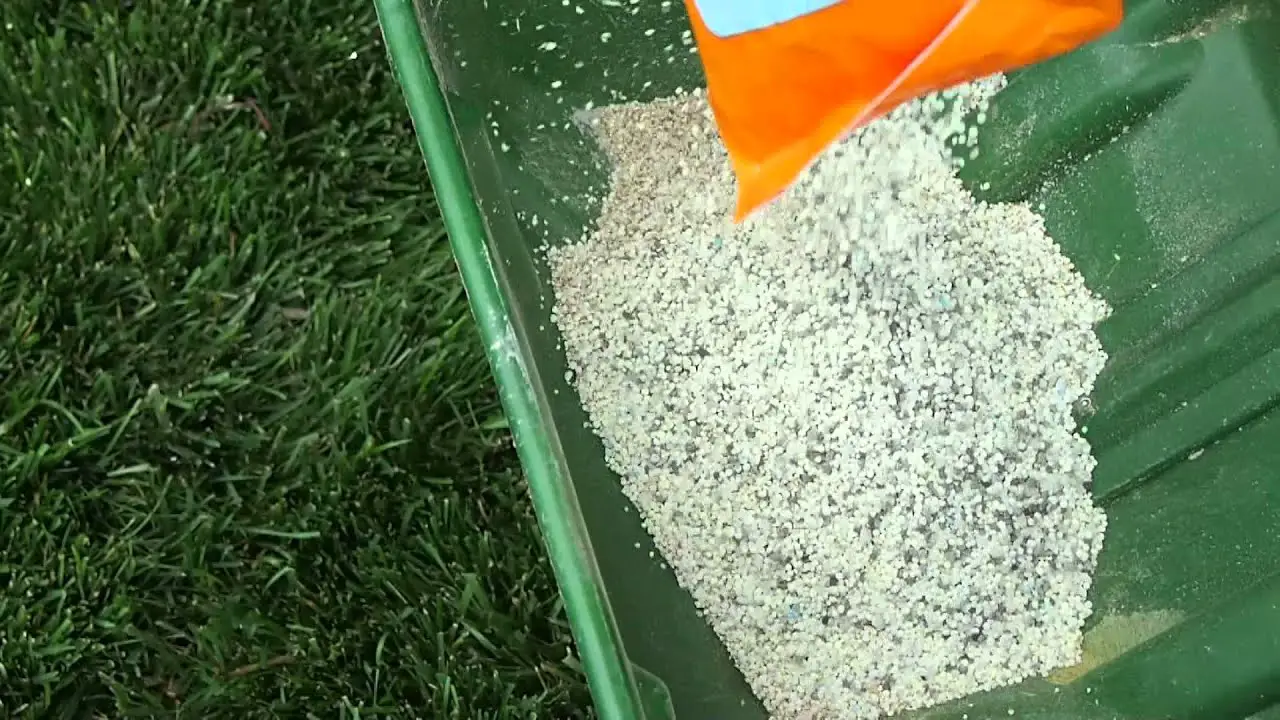How Do I Calculate How Much Fertilizer I Need
Fertilizer recommendations for lawns can be confusing to the average homeowner. These instructions are usually given in pounds of nitrogen to be applied per 1,000 square feet. Home gardeners often have difficulty converting these recommendations to the amounts needed for their selected grade of nitrogen fertilizer and their homes lawn size. Luckily, you can use online fertilizer calculators to simplify things.
Should I Water Lawn After Fertilizing
At Master Lawn, we typically say to wait 24 hours before watering your lawn after fertilizing. But it is important to make sure that it does receive a good watering session soon after that 24 hour waiting period. Watering helps the fertilizer to activate and to break down and begin feeding nutrients to the lawn.
How Long After Putting Down Grass Seed Can I Fertilize
You can fertilize the lawn immediately after or before applying the grass seed. This provides the grass with all the nutrients it would require for fast and healthy growth.
Also, when working with grass seeds, remember to plant them when the temperature is between 50 to 90 F. In case of the temperature being below 50, the seedlings, being planted recently, will be immature and can perish in a frost or extreme cold. And in case of the temperature being above 90 F, the seeds will not germinate as they enter latency and show little to no growth.
Don’t Miss: Orange Lawn Fungus
Comparison Between Granular Fertilizers
Organic fertilizers have added benefits such as micronutrients, potash, and microorganisms that are good for your soil. Synthetic fertilizer does not have these other components because it is a chemical fertilizer.
This is also a drawback of synthetic fertilizers as these chemicals are often poisonous. They can often be harmful to the environment when they end up in rainwater runoff that flows to bodies of water or seeps into the water table.
Ensure that the forecast does not call for heavy rainfall that might wash away the fertilizer.
Also, keep children and pets off of a freshly fertilized lawn until 24 hours after it has dried.
How long it takes for granular fertilizer to work depends largely on the type of fertilizer you use.
Synthetic fertilizers work far more quickly than organic fertilizers.
This is due to the need for organic fertilizers to decompose. The byproducts of the decomposition are what actually fertilize the soil.
Thus, someone looking for a quick boost or green-up will benefit more quickly from a synthetic fertilizer.
When And How To Fertilize Your Lawn

In some ways, lawns are a lot like people. Operating at the peak of beauty and performance requires a good diet and proper care. Lush, thick, green lawns depend on properly timed, properly balanced nutrition to look and grow their best. Understanding when and how to fertilize your lawn can help you and your grass stand out from the rest.
Don’t Miss: Craftsman Riding Mower Parts Lookup
Contact Us For Your Lawn Care Today
At J& C Lawn Care, we provide exceptional lawn care services including fertilization and lawn mowing for properties in the Greater Happy Valley, OR area. For residential and commercial property owners who donât have the gift of the green thumb, our services can make your lawn pristine. With our crewâs expertise, your yard will not only look excellent but will also stay healthy year-round.
When you need professional help keeping your lawn in tip-top shape, our experts are only a phone call away. Contact us at today to receive a quote for any of our services.
How Long After Fertilizing Should I Wait To Water My Lawn
It depends on the fertilizer. Some lawn foods perform better when you water them in right after applying, while otherssuch as some weed-and-feed productsneed to be watered a day or two after fertilizing. It all comes down to this: Check the product directions on the bagtheyll tell you when to water.
You May Like: Cost Of Trugreen Annual Plan
How Often To Fertilize New Grass
The transition from starting a new lawn, to getting into a fertilizing routine is where many get confused. A start fertilizer should only be applied during the preliminary stages of forming your new lawn. After the new seeds have germinated and have been given enough nutrients to become grass, theres no need to give your lawn starter or pre-turf fertilizer.
You are now looking to source a fertilizer thats suitable for your grass as well as your climate and vegetation conditions. At this stage, you can get into a lawn feeding schedule that matches your ambition to promote the growth of your new lawn. If youre looking to source a great lawn fertilizer, why not check our list of the best lawn fertilizers.
About the Author: Editorial Team
The Gardenknow editorial team leverages the knowledge, enthusiasm and experience of its team of gardening fanatics to provide the websites content. If you want to learn more about who we are and what we do read more here.
Can I Fertilize My Lawn Every 4 Weeks
Because nitrogen in slow-release fertilizers is available over time, the product can be applied less frequently and at higher rates and is less likely to burn the lawn. You can reapply slow-release fertilizers every six to eight weeks, while a fast-release fertilizer can be reapplied every four weeks.
Don’t Miss: Expert Gardener Lawn Fertilizer 30-0-4
Getting The Great Lawn Youve Been Wishing For
The decisions that you make for your lawn are important. As we mentioned early on, the timing of those decisions is also critical to your success. Proper fertilization and proper watering are two services that can play a huge role in your overall results, assuming that theyre performed properly.If youre currently performing DIY lawn care or using a lawn care professional but not seeing the results that you desire, then you might be looking to choose a different lawn care company in Memphis, TN or Northern Mississippi. After all, if you are investing in professional lawn care, you deserve to get the results youre wishing for.At Master Lawn, we believe that a healthy lawn is a team effort. While we will be performing professional fertilization services, were here to support you with your watering needs. That includes any watering questions that you might have. We can also connect you with our sister company if you prefer to take that work off of your plate and have a professional irrigation system installed. At the end of the day, we want to help you see your lawn succeed. You can count on us to be here for whatever you may need in making your healthy lawn wishes come true.If youre ready to work with a lawn care company in Memphis, TN and Northern Mississippi that will be there to provide you with guidance on any lawn care issues that arise, talk to a lawn care expert, choose from 3 program options, and become the master of your lawn.
How Long After Reseeding Or Overseeding My Lawn Should I Wait Before Fertilizing
Your best bet is to fertilize your newly seeded or overseeded lawn with Scotts® Turf Builder® Starter® Food for New Grass directly after seeding. Then, you need to wait 6 to 8 weeks before fertilizing again. If you get over-eager and think If a little fertilizer is good, then a lot of fertilizer is better, let us save you from yourself. Over-fertilizing at any time, especially with newly seeded lawns, can actually damage your grass and that is no way to win the Yard of the Month award.
Also Check: How To Kill Wild Violet
How Long After Fertilizing Can I Overseed
Related Articles
There are two basic reasons why you overseed a lawn: for a winter lawn or because your lawn is performing poorly. Although the process for the two approaches is different, the fertilizing techniques are basically the same. To ensure your success, follow a few simple guidelines before you overseed.
When’s The Best Time To Plant

The best time to plant depends on where you live and the type of grass youre planting. If you live in the North and are planting cool-season grass varieties, like Kentucky bluegrass, perennial ryegrass, or fescues, the best time to plant grass seed is the spring and again in the fall. Cool-season grasses grow most actively when the air temperatures are between 50 and 80 degrees F, the soil temperature is 50 to 65 degree F, and rain is plentiful. Cool-season grasses go dormant and do not grow during hot weather, when the soil temperature goes above 65 degrees F. Since this is common during the peak summer months, planting cool-season grass seed can result in poor seed germination or even seedling death.
On the other hand, if you live in the South and are planting warm-season grass varieties, like centipedegrass, zoysiagrass, bahiagrass, or bermudagrass, the best time to seed is late spring through mid-summer. Warm-season grasses are originally from tropical areas of the world and, once established, are able to thrive in scorching sun and high temperatures. They grow most actively when air temperatures are warm, between 70 and 90 degrees F. In addition, seeds need warmer soil temperatures than cool-season grasses to germinate .
Also Check: Lowes Financing Lawn Mower
How Long To Water A Lawn After Fertilizing
Your lawns watering needs can change based on the weather conditions. But you probably want at least some idea of how long or how often, to water. While we recommend watering 1 to 2 times a week once the fertilization season starts in early spring , in the heat of the summer, that can be easily ramped up to 3 to 4 times per week. Its important that your lawn continues to receive ample water, even through the hottest days. Drought stress can really do a lot of damage to a lawn.In addition, your lawn care professional will also know exactly how much fertilizer to apply during periods of drought. This is important as forcing your grass to grow too much with fertilization during periods of drought can actually end up harming your lawn.
How Often Should You Put Epsom Salt On Your Lawn
Some homeowners like to use Epsom salt as a natural lawn fertilizer in the spring to facilitate lush green growth. Epsom salt contains magnesium, which is key to seed germination, chlorophyll production, and improving the uptake of nitrogen, phosphorus, and sulfur.
To try this method, add 2 tablespoons to each gallon of water used on the lawn. If you have a sprinkler system, lightly sprinkle the salt directly atop the grass and then allow the system to water it into the sod.
Recommended Reading: How To Make Lines In Lawn
Learn More About Revive
An application of Revive to those dry areas in summer will work wonders. Revive contains a special combination of surfactants that help re-wet hard-packed and dry areas. Revives organic nutrients will re-invigorate those dry lawn areas and make them lush and green again.
You can have your dream-come-true lawn with these easy steps and help from your local experts at any IFA Country Store. Stop by and talk with us about our 4 step lawn care program. It provides not only the lushest, deepest green, weed-free turf, but improved, insect-free soil that grows deeper, stronger roots. Overall, it grows a healthier lawn that requires less water and holds up better through heat and drought with consistent seasonal applications. With 23 locations ready to serve you, a beautiful lawn is just an application away.
Feeding The Lawn In The Summer And Fall
Warm-season grasses thrive in the heat of the summer and can be fertilized throughout the growing season. However, cool-season grasses are in a survival mode during the heat of the summer. Refrain from applying fertilizer to a lawn in mid- or late-summer if you live in a climate where cool-season grasses are in your lawn seed mix. A cool-season lawn should need nothing other than water and pest management until September.
Most lawn experts recommend a mild dose of a “turf-builder” fertilizer formulation in the early- to mid-fall, while the turf still has several weeks of active growth before dormancy. This application will help build robust root systems going into winter and restart the growing cycle in the spring. You are not looking to return your lawn to the green of summer. Heading into winter, you can expect a natural slowdown of your lawn’s growth and the loss of its green luster.
Recommended Reading: Getting Rid Of Violets In Lawn
What Do You Do If You Burn Your Lawn With Fertilizer
If youve overdone it with the fertilizer, you may still be able to save your lawn. Burned lawns will need a generous amount of water to get back to green. Its vital that you water the lawn as soon as you spot any brown or yellow patches to prevent further damage. Slowly soak the affected areas every day for about a week to fully flush out the extra salt. To avoid causing sun damage while the lawn is in crisis, be sure to water early in the morning. Within a few weeks, the affected areas should be turning back to green. If not, those areas of your lawn may need to be dug up and overseeded to inspire new growth.
Do You Water Lawn After Fertilizing
At Master Lawn, we typically say to wait 24 hours before watering your lawn after fertilizing. But it is important to make sure that it does receive a good watering session soon after that 24 hour waiting period. Watering helps the fertilizer to activate and to break down and begin feeding nutrients to the lawn.
Read Also: Does Lowes Service Lawn Mowers
How Many Days Before Period Is Peak Fertility
Ovulation happens about 14 days before your period starts. If your average menstrual cycle is 28 days, you ovulate around day 14, and your most fertile days are days 12, 13 and 14. If your average menstrual cycle is 35 days ovulation happens around day 21 and your most fertile days are days 19,20 and 21.
Can I Overseed And Fertilize At The Same Time

Is it OK to Fertilize After Overseeding? It is perfectly safe to fertilize after overseeding your lawn. In fact, applying a specialized lawn starter fertilizer will increase the number of grass seedlings that survive to adulthood. For best results, apply a starter fertilizer within 3 days over overseeding.
Read Also: How To Bid Mowing Jobs
Should I Fertilize When I Plant Grass Seed
No, it is not advisable to fertilize soil while planting seeds. That is because it can become a cause for the irregular scattering and irregular growth of plants. It can result in damaging your lawn, leaving dry patches having colors like yellow or brown and making it look scorched.
Also, the thumb rule for fertilization is Less is more. Fertilization may nourish your plants and help them grow better however, adding more fertilizers can burn them out. And resultantly, make your lawn look untidy, cluttered, and mutilated.
Fertilizing At The Wrong Time
“Many homeowners don’t follow a lawn fertilizer schedule. They fertilize when they think their lawn needs it, when they have time or when the stuff is on sale.
Here’s when to fertilize lawn: If your lawn fertilizer schedule is once per year, apply it around Labor Day. Thats when your lawn is the hungriest and when it will respond best to the nutrients it receives. Fertilizing at this time will help replenish food reserves after a long, stressful year of growing and before the harshness of winter sets in.
If your lawn fertilizer schedule is twice per year, apply the second application about the middle of October. This acts like a second helping of much-needed food going into winter. A third application can be added in mid to late spring and can be combined with your crabgrass preventer. A fourth application, if you feel the need, can be added mid-summer. Watch the weather when applying midsummer fertilizers. Fertilizing during hot, humid weather can harm your lawn. An exception would be using an organic fertilizer. They are much more lawn friendly during the dog days of summer.
In the spring, apply just enough fertilizer to help green up your lawn. About half the normal amount will do. Even without fertilizer, your lawn naturally grows quickly as soon as temperatures become consistently higher. Have you ever noticed that grass grows fastest in the late spring and early summer? Why promote even more growth at this time by fertilizing?
Recommended Reading: Lawn Mowing Hiring
What Happens If You Over
An over-fertilized lawn is the worst nightmare of a gardener. When you over-fertilize a garden, all the salts present in the fertilizer build up in the soil. This excessive buildup of salt causes the areas where fertilizer has been applied to be dried out or become patchy.
Its similar to when we consume more salt than required our tongue feels dry, the heart starts racing, you feel like drinking more and more water, etc.
This dried up part of the lawn often becomes yellow, light brown, or green. And this condition is quite prevalent. This practice refers to fertilizer burn. Its not always lethal, but it can be hard to tell if your lawn is ever going to recover or not. The remotely yellow color means that the grass is in recoverable stage, but the brown color means you better just say bye to it.
TIP: Recovery of your lawn depends upon the moisture available in the grass, type and amount of fertilizer deployed, and most importantly, the health of your lawn on the whole. Similarly, recovery of your lawn is also dependent upon your intervention and how fast you intercede.
